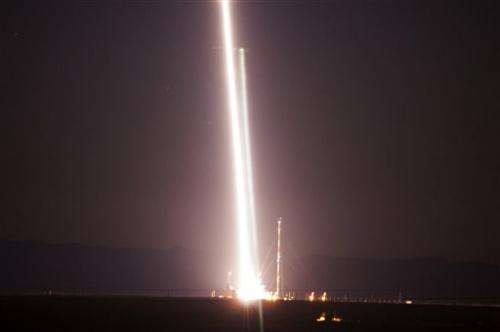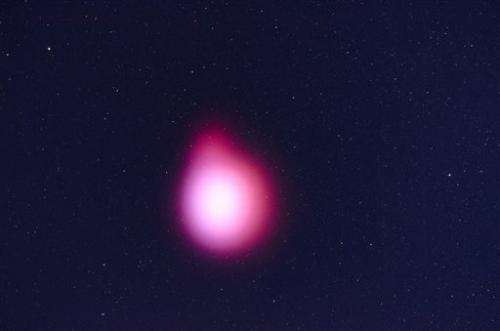Pink cloud visible in Arizona after New Mexico rocket launch

(AP)—Early risers across much of Arizona were treated to a colorful sight—a pink cloud from a NASA research rocket that was launched Wednesday from a U.S. Army installation in New Mexico.
The rocket was launched from White Sands Missile Range at 5:26 a.m., and a bright pink cloud was visible for the next 20 minutes as sunlight hit the vapor released from the rocket, range spokeswoman Cammy Montoya said.
News outlets in Arizona reported that residents in Phoenix, Tucson, Lake Havasu City and Flagstaff reported seeing the cloud.
The rocket carried an atmospheric-research payload designed by scientists and engineers at a space-vehicles research lab at Kirtland Air Force Base in Albuquerque.
White Sands officials said the rocket's release of vapor into the near-vacuum of space was intended to help study processes responsible for the formation of the Earth's ionosphere.
That's a region of space where electrons naturally separate from molecules and float separately to create an ionized gas.
The experiment, which also involved using ground stations to take measurements of the ionosphere, was intended to develop scientific explanations for ionospheric disturbances and their effects on modern technology, officials said.
The rocket was provided under a Department of Defense test program at Kirtland, while a NASA rocket program provided technical expertise for its assembly and other parts of the mission.
The launch was postponed from Monday because of weather.
-

This photo provided by the Department of Defense U.S. Army White Sands Missile Range shows a NASA Terrier-Black Brant research rocket that launched from White Sands Missile Range, in N.M. early Wednesday, Feb. 25, 2015, just beyond the reaches of the earth's atmosphere. The rocket is carrying an experiment to study ionization in space. (AP Photo/Department of Defense U.S. Army White Sands Missile Range, Drew Hamilton) -

This photo provided by the Department of Defense U.S. Army White Sands Missile Range shows the release of vapor that the NASA Terrier-Black Brant research rocket left in the near-vacuum of space, just minutes after it launched on Wednesday, Feb. 25, 2015. The launch was intended to study processes responsible for the formation of the earth's ionosphere. (AP Photo/Department of Defense U.S. Army White Sands Missile Range, Drew Hamilton)
© 2015 The Associated Press. All rights reserved.


















